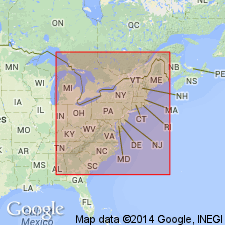
- Usage in publication:
-
- Elk Park Plutonic Suite*
- Modifications:
-
- Named
- Geochronologic dating
- Dominant lithology:
-
- Gneiss
- AAPG geologic province:
-
- Piedmont-Blue Ridge province
Summary:
The informal Elk Park plutonic group of Rankin and others (1973) is here named the Elk Park Plutonic Suite in northwestern North Carolina. It is an orogenic calc-alkaline suite whose protoliths were fine-grained to coarsely porphyritic diorites to quartz monzonites. It includes the basement plutonic Cranberry Gneiss of the Blue Ridge thrust sheet in northwestern NC, and the Blowing Rock and Wilson Creek Gneisses in the Grandfather Mountain window. Age is Middle Proterozoic based on a discordia intercept age of 1079 m.y.
Source: GNU records (USGS DDS-6; Reston GNULEX).

- Usage in publication:
-
- Elk Park Plutonic Group
- Modifications:
-
- Areal extent
- AAPG geologic province:
-
- Piedmont-Blue Ridge province
Summary:
Elk Park plutonic group of Rankin and others (1973) is used formally on the VA State map. [No explanation given for usage of Group rather than the preferred term Suite.] Unit is mapped in Grayson Co. where it is divided into two map units--an augen gneiss and porphyritic gneiss; and an equigranular quartz monzonite, quartz monzonite flaser gneiss, and quartz monzonite gneiss. Rocks range in composition from diorite to quartz monzonite. Most are quartz monzonite in which the primary dark mineral is biotite, with or without hornblende. Epidote and titanite are common accessories. Porphyritic rocks contain microcline phenocrysts. Augen gneiss probably derived from porphyritic plutonic rocks by shearing. Unit includes in part the Little River Gneiss of Dietrich (1959) and the Cranberry Gneiss (Rankin and others, 1973).
Source: GNU records (USGS DDS-6; Reston GNULEX).
For more information, please contact Nancy Stamm, Geologic Names Committee Secretary.
Asterisk (*) indicates published by U.S. Geological Survey authors.
"No current usage" (†) implies that a name has been abandoned or has fallen into disuse. Former usage and, if known, replacement name given in parentheses ( ).
Slash (/) indicates name conflicts with nomenclatural guidelines (CSN, 1933; ACSN, 1961, 1970; NACSN, 1983, 2005, 2021). May be explained within brackets ([ ]).

